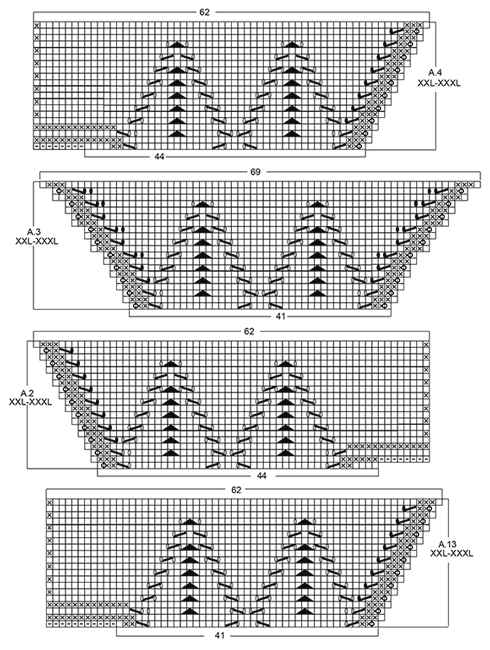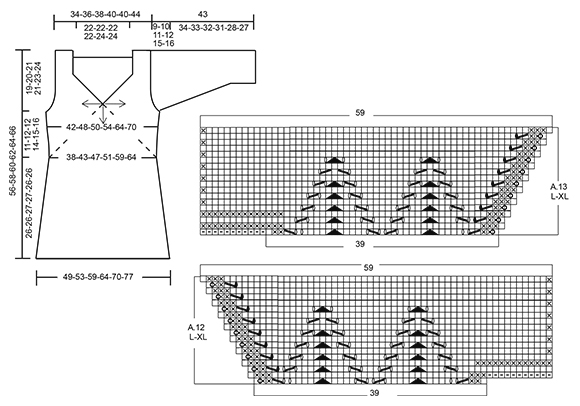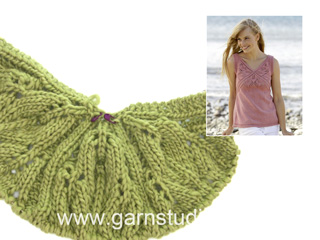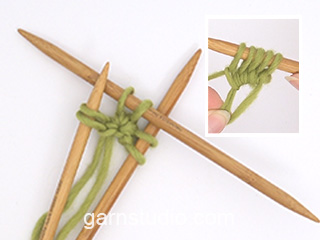Butterfly Heart |
|||||||||||||||||||||||||||||||
 |
 |
||||||||||||||||||||||||||||||
Knitted DROPS jumper with lace pattern and V-neck in ”Belle”. Worked top down. Size: S - XXXL.
DROPS 170-3 |
|||||||||||||||||||||||||||||||
|
GARTER ST (back and forth): K all rows. 1 ridge = K2 rows. PATTERN: See diagrams A.1 to A.13. The diagrams show all rows in pattern seen from RS. See diagram for correct size. SHORT ROWS: When turning in short rows, slip first st as if to K. Tighten thread and make sure to avoid big holes. INCREASE TIP: All inc are done from RS. Inc 1 st by making 1 YO, on next row P YO twisted to avoid holes. DECREASE TIP: All dec are done from RS! Dec 1 st at beg of row as follows: K 1, slip 1 st as if to K, K 1, psso Dec 1 st at end of row as follows: Work until 3 sts remain (includes the 2 new sts worked for the first time), K 2 tog. ---------------------------------------------------------- JUMPER: Work from the middle of V-neck and out in 3 triangles on front piece and 4 triangles on back piece, then work downwards. FRONT PIECE: Work back and forth from neck and down. Cast on 8 sts on circular needle size 4 mm / US 6 with Belle. K 1 row. On next row inc as follows: * K 1, 1 YO *, repeat from *-* until 1 st remains and finish with K 1 = 15 sts on needle. Work next row as follows (from RS): Work YOs from previous row twisted, they should not make holes. Work 3 sts in GARTER ST - see explanation above, A.1, insert 1st marker, A.1, insert 2nd marker, A.1 (= repeat A.1 3 times in total on row), finish with 3 sts in garter st. REMEMBER THE KNITTING GAUGE When A.1 has been worked 1 time vertically, there are 123-123-123-123-129-129 sts on needle. Piece measures approx. 11-11-11-11-12-12 cm / 4½"-4½"-4½"-4½"-4 3/4"-4 3/4" from cast-on edge. Work next row as follows from RS: Work A.2 over the first 42-42-42-42-44-44 sts, A.3 over the next 39-39-39-39-41-41 sts and A.4 over the last 42-42-42-42-44-44 sts, after A.4 cast on 8 sts at the end of row for shoulder (see diagram). Work A.4 to A.2 on next row, after A.2 cast on 8 sts at the end of row for shoulder (see diagram). When A.2 to A.4 have been worked 1 time vertically, there are 165-165-183-183-193-193 sts on needle. Piece measures approx. 15-15-17-17-19-19 cm / 6"-6"-6 3/4"-6 3/4"-7½"-7½" from cast-on edge. READ ALL OF THE FOLLOWING SECTION BEFORE CONTINUING! WORK PATTERN AS BEFORE WHILE AT THE SAME TIME WORKING SHORT ROWS IN EACH SIDE OF PIECE. PATTERN: Work next row as follows from RS: Work 1 st in garter st, 48-48-52-52-55-55 sts in stockinette st, work A.5 over the next 6 sts, (marker), A.6 over the next 6 sts, 43-43-53-53-57-57 sts in stockinette st, A.7 over the next 6 sts, (marker), A.8 over the next 6 sts, 48-48-52-52-55-55 sts in stockinette st, finish with 1 st in garter st. Repeat A.5 to A.8 over the 6 sts on each side of each marker 2-3-2-3-4-5 times in total, then repeat the first 0-0-6-4-4-4 rows of A.5 to A.8 1 more times. SHORT ROWS: AT THE SAME TIME when 2-6-0-2-0-6 rows of A.5 to A.8 have been worked, work SHORT ROWS - see explanation above - in each side of piece as follows: Work until 26-26-24-23-18-18 sts remain on row (work A.5 to A.8 as before), turn and work until 26-26-24-23-18-18 sts remain, turn piece. Then work short rows in the different sizes as follows: SIZE M: Work 6 sts less for every turn 2 times in each side of piece. SIZE L-XL: Work 6 sts less for every turn 1-2 times in each side of piece, then work 4 sts less on every turn 3-2 times in each side of piece. SIZE XXL-XXXL: Work 6 sts less for every turn 1-1 time in each side of piece, then work 4 sts less for every turn 4-4 times in each side of piece, then work 2 sts less on every turn 4-5 times in each side of piece. ALL SIZES: When the short rows have been worked, work last row from WS, so that next row beg from shoulder. Then work over all sts from RS as follows: Work in garter st over the first 42-44-46-48-50-52 sts AT THE SAME TIME inc 0-2-4-4-6-6 sts evenly, work as before (i.e. A.5 to A.8 and stockinette st) until 42-44-46-48-50-52 sts remain, work in garter st over the last sts AT THE SAME TIME inc 0-2-4-4-6-6 sts evenly (= 42-46-50-52-56-58 sts in garter st in each side of piece). Work 3 rows in garter st over the outermost 42-46-50-52-56-58 sts in garter st in each side of piece, pattern and stockinette st over the remaining sts. On next row from WS work as follows: K the first 40-44-48-50-54-56 sts and slip them on a stitch holder for sleeve, work 2 sts in garter st, work in stockinette st and pattern as before until 42-46-50-52-56-58 sts remain, 2 sts in garter st, K the next 40-44-48-50-54-56 sts and then slip them on a stitch holder for sleeve. Cut the yarn. 8-8-8-12-12-12 rows of A.5 to A.8 remain. Beg next row from RS. Continue to work in garter st over the first and last 2 sts in each side of piece. When A.5 to A.8 have been worked, there are 23-25-26-27-32-34 sts before 1st marker, 79-91-99-107-123-135 sts between 1st and 2nd marker and 23-25-26-27-32-34 sts after 2nd marker = 125-141-151-161-187-203 sts in total on row. Piece measures approx. 21-24-25-27-32-35 cm / 8 1/4"-9½"-9 3/4"-10½"-12½"-13 3/4" on the widest measured from cast-on edge. Insert 1 marker in piece, NOW MEASURE PIECE FROM HERE. On next row from RS loosely bind off the first 22-24-25-26-31-33 sts knitwise, work 1 edge st in garter st, (marker), work A.9 over the first 6 sts after marker, stockinette st over the next 67-79-87-95-111-123 sts, A.10 over the last 6 sts before second marker, (marker ), 1 edge st in garter st, loosely cast of the last 22-24-25-26-31-33 sts knitwise = 81-93-101-109-125-137 sts remain on row. Cut the yarn. Work next row from WS over the remaining sts as follows: 1 edge st in garter st, A.10 as before, stockinette st over the next 67-79-87-95-111-123 sts, A.9 as before, 1 edge st in garter st. When A.9 and A.10 have been worked 1 time vertically, continue in stockinette st with 1 edge st in garter st in each side of piece. When piece measures 3 cm / 1'' from marker, inc 1 st in each side of piece inside 1 edge st (= 2 sts inc) - READ INCREASE TIP. Repeat inc every 1½-1½-1½-1-1-1 cm / ½"-½"-½"-3/8"-3/8"-3/8" 12-10-12-14-12-13 times in total = 105-113-125-137-149-163 sts on needle. When piece measures 23-23-24-24-23-23 cm / 9"-9"-9½"-9½"-9"-9" from marker (piece measures 53-55-57-59-61-63 cm / 21''-21 5/8''-22½''-23¼''-24''-24¾'' in total from shoulder), adjust so that next row is from RS, switch to circular needle size 3.5 mm / US 4. Work next row from RS as follows: Work 1 edge st in garter st, work A.11 (= 2 sts) until 2 sts remain, work first st in A.11, finish with 1 edge st in garter st. On row with holes (i.e. 7th row) work next to last st K. Bind off when A.11 has been worked 1 time vertically. Piece measures 56-58-60-62-64-66 cm / 22''-22¾''-23 5/8''-24 3/8''-25¼''-26'' in total from shoulder. BACK PIECE: Piece is first worked in the round, then worked as front piece. Cast on 6 sts on double pointed needles size 4 mm / US 6 with Belle, switch to circular needle when needed. K 1 row. On next row inc as follows: * K 1, 1 YO *, repeat from *-* = 12 sts on row, K YOs twisted on next row, they should not make holes. Work A.1 4 times in total, insert 1 marker between each A.1 (= 4 markers). When A.1 has been worked 1 time vertically, there are 156-156-156-156-164-164 sts on needle. Continue as follows: A.12 over the first 39-39-39-39-41-41 sts, work A.3 over the next 39-39-39-39-41-41 sts and A.13 over the last 39-39-39-39-41-41 sts, slip the remaining sts on a stitch holder for neck edge (= 39-39-39-39-41-41 sts), after A.13 cast on 11 sts at the end of row for shoulder (see diagram). Then work back and forth on needle. Work A.13/A.3/A.12 on next row, after A.12 cast on 11 sts at the end of row for shoulder (see diagram). When A.12/A.3/A.13 have been worked 1 time vertically, there are 165-165-183-183-193-193 sts on needle. Piece measures approx. 15-15-17-17-19-19 cm / 6"-6"-6 3/4"-6 3/4"-7½"-7½" from cast-on edge. Now continue back piece as front piece. NECK EDGE: Worked back and forth on needle. Slip sts from stitch holder for neck edge on back piece back on circular needle size 3.5 mm / US 4. Work 2 ridges. Fasten ridges where sts were cast on for shoulder. Fasten off. ASSEMBLY: Sew the side seams inside 1 edge st in garter st. Sew shoulder seams inside 1 edge st in garter st. Tighten tog the middle (i.e. cast-on edge) on both front and back piece. SLEEVE: Worked back and forth on circular needle in stockinette st. Slip sts from the 2 stitch holders (on front and back piece) in one side of piece back on circular needle size 4 mm / US 6 = 80-88-96-100-108-112 sts. Work short rows for sleeve cap as follows: Beg to work in the 25th-29th-31st-35th-43rd-45th st (i.e. 24-28-30-34-42-44 sts in one side are not worked). Work from RS 34-34-38-34-26-26 sts in stockinette st, turn piece (= 22-26-28-32-40-42 sts remain on needle). Work in stockinette st over the 36-36-40-36-28-28 sts, turn piece. Work 2 sts more on every turn in each side of piece until all sts have been worked. AT THE SAME TIME dec 1 st in each side of piece (= 2 sts dec), inside 1 st on every 4th-4th-2nd-4th-4th-4th row 4-6-8-8-10-10 times in total – READ DECREASE TIP = 72-76-80-84-88-92 sts on needle. Work 8-8-8-12-12-12 rows in stockinette st over all sts, insert 1 marker in piece (sew side seam on sleeve up to here later). NOW MEASURE THE PIECE FROM HERE. Cast on 1 edge st at the end of the next 2 rows = 74-78-82-86-90-94 sts. Work edge sts in garter st until finished measurements. On next row from RS dec 1 st inside 2 sts in each side of piece (= 2 sts dec). Repeat dec every 2½-2-2-1½-1-1 cm / 7/8"-3/4"-3/4"-½"-3/8"-3/8" 9-10-11-12-13-13 more times = 54-56-58-60-62-66 sts on needle. When sleeve measures 31-30-29-27-24-23 cm / 12 1/4"-11 3/4"-11½"-10½"-9½"-9", switch to circular needle size 3.5 mm / US 4. Work 2 ridges. Bind off. Slip sts from stitch holders in the other side of piece on circular needle size 4 mm / US 6 and work the same way. ASSEMBLY: Sew sleeve seams up to where 1 edge st in garter st was cast on in each side of piece. Sew the under arm seam. |
|||||||||||||||||||||||||||||||
Diagram explanations |
|||||||||||||||||||||||||||||||
|
|||||||||||||||||||||||||||||||

|
|||||||||||||||||||||||||||||||

|
|||||||||||||||||||||||||||||||

|
|||||||||||||||||||||||||||||||

|
|||||||||||||||||||||||||||||||

|
|||||||||||||||||||||||||||||||
|
Have you made this or any other of our designs? Tag your pictures in social media with #dropsdesign so we can see them! Do you need help with this pattern?You'll find tutorial videos, a Comments/Questions area and more by visiting the pattern on garnstudio.com. © 1982-2024 DROPS Design A/S. We reserve all rights. This document, including all its sub-sections, has copyrights. Read more about what you can do with our patterns at the bottom of each pattern on our site. |
|||||||||||||||||||||||||||||||







































































Comments / Questions (154)
Salve! devo lavorare la manica. ho rimesso le 80m sul ferro, e lavoro a ferri accorciati ogni volta 2m in più fino a lavorarle tutte. Non capisco dove dice "allo stesso tempo diminuire"... vuol dire che devo iniziare a diminuire durante i ferri accorciati? ovvero che la diminuzione non sarà a fine giro ma prima di voltare il lavoro? o devo iniziare a diminuire dopo aver lavorato tutte le maglie a fine ferri accorciati? grazie
30.05.2019 - 00:01DROPS Design answered:
Buongiorno Stefania. Deve diminuire mentre sta lavorando i ferri accorciati, dopo la prima maglia all'inizio del ferro accorciato e prima dell'ultima maglia alla fine del ferro accorciato. Diminuisce così 4 volte ogni 4 ferri: in tutto 8 maglie diminuite. Alla fine dei ferri accorciati ci saranno 72 m. Buon lavoro!
30.05.2019 - 06:53A jelmagyarázatnál félre érthető a leírás. A ráhajtásoknál "2 rh két szem között"-et ír. A videóban 1 ráhajtást köt.
27.05.2019 - 17:02Liebes Drops-Team, wie so viele andere auch hänge ich bei den verkürzten Reihen fest... 1) Ich stricke S und finde keine Ang, ausser das mit den bis 26 M. Aber dann? Str ich wie für M mit beids über 6 M, beids 2x? Meint das 6 M vor dem 1. Wenden bei 26 M, also bei 32 und dann bei 38? Oder lasse ich das bei S ganz weg? 2) Das ALLE GR ist nur eine Reihe. Wie geht die RückR? 3) Was ist mit dem "Anschlagrand" gemeint? Die Mitte? Vielen Dank für die diversen Antworten!
26.05.2019 - 15:47DROPS Design answered:
Liebe Susy, in der Grösse S gibt es nur 2 verkürzten Reihen (= bis 26 M stricken bei der Hin- sowie der Rückreihe), dann stricken Sie weiter wie unter ALLE GRÖSSE. Mit Anschlagrand bedeudet man, von der Anschlagskante. Viel Spaß beim stricken!
27.05.2019 - 13:12Al meteen in het begin een vraag over het VOORPAND: Brei de volgende nld als volgt (aan de goede kant): brei omsl van vorige nld gedraaid, er moeten geen gaatjes ontstaan. Brei 3 st in RIBBELST - zie uitleg boven, A.1, plaats 1e markeerder, A.1, plaats 2e markeerder, A.1 (= herhaal A.1 3 keer in totaal op de nld) en eindig met 3 st in ribbelst. \r\nMoet dit allemaal in die ene nld gebeuren, of eerst een nld waarin de omsl gedraaid gebreid worden, en daarna een nld met 3 ribbelst, A1, enz?
07.04.2019 - 21:47Al meteen in het begin een vraag :) VOORPAND: Brei de volgende nld als volgt (aan de goede kant): brei omsl van vorige nld gedraaid, er moeten geen gaatjes ontstaan. Brei 3 st in RIBBELST - zie uitleg boven, A.1, plaats 1e markeerder, A.1, plaats 2e markeerder, A.1 (= herhaal A.1 3 keer in totaal op de nld) en eindig met 3 st in ribbelst. Moet dat allemaal in die ene nld gebeuren, of eerst een nld waarin de omslagen gedraaid gebreid worden, en daarna een nld met 3 ribbelst enz.?
07.04.2019 - 21:40DROPS Design answered:
Dag Bloem,
Dat moet inderdaad allemaal in 1 naald. Dus je breit eerst 3 st. in ribbelsteek, dan A.1, plaats een markeerder en zo verder....Als je omslagen tegen komt van de vorige toer dan brei je die gedraaid zodat er geen gaatje ontstaat.
09.04.2019 - 21:07Bonjour J'ai réalisé cet ouvrage jusqu’à l'assemblage. ( dos et devant) Je ne comprends pas comment on reprend l'encolure ni les explications des manches. Pouvez-vous détailler ces 2 étapes ? Merci d'avance Bien cordialement
06.04.2019 - 17:44DROPS Design answered:
Bonjour Mme Broda, pour l'encolure dos, vous avez mis en attente 39-41 m (cf taille), vous reprenez ces mailles sur l'aiguille et tricotez 4 rangs endroit (= 2 côtes mousse), rabattez et cousez les bords de ces côtes mousse de chaque côté aux mailles montées pour les épaules. Les manches se tricotent à partir des mailles en attente mais en commençant à la maille indiquée pour la taille pour former l'arrondi de la manche, puis vous tricotez 2 m en plus à la fin de chaque rang (= de chaque côté) tout en diminuant tous les 2 ou 4 rangs. Bonne continuation!
08.04.2019 - 09:24V.a. de 183 steken en meteen de verkorte toeren in maat L ?
14.03.2019 - 17:24DROPS Design answered:
Dag Veerle,
Als je 183 steken op de naald hebt, brei je A.5 t/m A.8 zoals beschreven in de tekst en tegelijkertijd brei je verkorte toeren. Lees eerst even alles door om te begrijpen wat je precies moet doen en in welke volgorde.
15.03.2019 - 18:22Tot nu toe alles prima gegaan, als laatste staat er bij het achterpand “ga nu verder op het achterpand als op het voorpand” ? Waar ga ik dan precies verder ?
14.03.2019 - 17:12DROPS Design answered:
Dag Veerle,
Als je op dat punt bent brei je het achterpand verder zoals je het voorpand ook vanaf dat punt gebreid hebt. Dus als je 165-165-183-183-193-193 st op de nld hebt en het werk meet ongeveer 15-15-17-17-19-19 cm vanaf de opzetrand, dan brei je het achterpand zoals beschreven staat onder LEES ALLE ONDERST.... bij het voorpand.
15.03.2019 - 18:25Hola estoy con la espalda y no entiendo cuando dice ahora seguir como con el frente pero a partir de dónde se debe seguir? Gracias
05.09.2018 - 13:52DROPS Design answered:
Hola Raquel, se debe seguir desde donde el frente mide 15-15-17-17-19-19 cm desde la orilla de montaje.
09.09.2018 - 18:42Voor maat XL brei ik 28 pennen in totaal over patroon A5 t/m A8. Eerst 2 pennen in patroon dan 10 pennen verkorte toeren =12 pennen. Als de verkorte toeren klaar zijn, brei dan de laatste nld aan de verkeerde kant zodat de volgende nld begint bij de schouder = 14 pennen. Brei dan over alle st aan de goede kant als volgt…=16 pennen. Dan 3nld ribbelsteek in totaal dus 2 pennen erbij is 18 pennen. Dan houd ik 10 pennen over ipv 12. pennen. Waar ga ik in de fout? Alvast bedankt voor uw hulp
04.09.2018 - 21:16DROPS Design answered:
Dag Mirjam, Als de verkorte toeren klaar zijn hoef je niet nog 2 extra naalden te breien, het gaat erom dat je weer op de goede kant begint. Volgens mij zitten hier de 2 extra naalden, waardoor je 10 over houdt, ipv 12.
19.09.2018 - 20:20